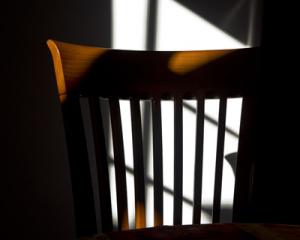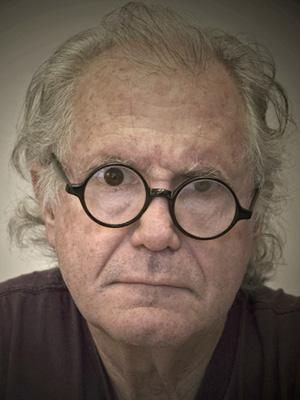It is simply a dining-room chair of pleasing design. Over the years it has acquired distinction because of the remarkable glutei maximi that it has cradled.

Guests have included college presidents, scholars from Berkeley, The California College of the Arts, Stanford, Yale, Oxford, Tuebingen, my alma mater the University of Cape Town, and other institutions; authors, artists, a Shakespeare scholar, lawyers, an astrophysicist, theologians, mathematicians, editors, a museum director, musicians, psychologists, physicians, a Justice devoted to human rights law, and my “brother,” playwright Rick Foster, one of the most deeply cultured and educated people I’ve ever known. They have been guests here not because of their titles, but because they have contributed so warmly and generously to discussions over food and wine. Rick’s response to my last column was so enlightening that I invited him to be my guest columnist, to occupy, as it were, the Distinguished Chair.
Raphael Shevelev
______________________________________
In The Art of Subversion, his October 2013 column, Raphael argues forcefully and persuasively that to judge any work of art by its adherence to a set of rules is to commit a fundamentally anti-artistic act. An act destructive to the very perception of art. Yet it also points to the need for a broader discussion of rule-making and rule-breaking as essential human activities
The birth and death of any set of rules is a complex topic. Rules pre-date civilization. The Bible and the Homeric Epics, not to mention Greek Tragedy, are filled with fraught dramatizations of the failures of the existing rules of conflict resolution - struggles that are still paramount in the twenty-first Century.
Within the arts there is also evidence of rules - and rule-breaking - going far back in time. Look at the rules that one can infer from the extreme stability of ancient Egyptian art for over a millennium, and at the astonishing, delightful, and short-lived changes during and just after the reign of Akhenaten.
In recent centuries when basic values are hotly contested within and between societies, and the progress of science and technology pose so many new and interesting challenges, artists are continually faced with fresh problems to solve. But that's what artists are: problem solvers. Their task is to integrate the raw data of our environment into stories, sounds, gestures, and images that carry deep meaning.

Being social animals, we form a loose, or not so loose, consensus as to how a problem is to be solved in our group. If you wanted to paint a successful landscape in Europe in 1450, you had to employ the rules of mathematical perspective. The consensus begins as description but then hardens into a prescription, i.e. a rule. Other solutions to the problem are “ruled” out. Eventually our more inquiring minds either get bored with repeating the same old solutions, or external changes provoke artists to investigate totally new problems, problems that cannot be solved by using the old methods. Things generate their opposite: rules give birth to the practice of their own breaking. In this light, the rules play a useful role in change. Their rigidity challenges us to go beyond them. They clarify just what it is that needs to be done differently in order to be fresh and apposite. Conservatives are left behind feeling superior and insecure. A new consensus is formed, which will provoke new rules that produce exciting results, for a while.
This is basically old stuff. But lately I've been thinking about the meta-problem—how is it that our species finds, or rejects, meanings in particular images, gestures, musical sounds, or groups of words? I recently saw a documentary called Picasso and Braque Go to the Movies. It brilliantly explores the way that films of the early years of the last century had a symbiotic relationship with the painters who developed cubism. They were actually reflecting the way that a whole civilization was coming to see the world differently - at the neurological level - because of stop-action and moving pictures.
Neurological science is now challenging our fundamental assumptions about how we perceive, judge, describe, and remember our world. There are powerful rules embedded in these assumptions. Courts of law rule that eyewitness accounts are to be taken most seriously in determining the guilt or innocence of the accused. But there is now overwhelming scientific evidence that eyewitness accounts are extremely unreliable and have punished many of the innocent and freed many of the guilty. When we say, “Speak, Memory!” and memory speaks, how are we to judge the truth of its sincere utterances? Memory has been influenced by the stories that we have found meaningful, the values and superstitions we have received, the images we have found beautiful or disgusting, the definition of heroism that we have embraced, and all of these have been conveyed by the art we have been given or sought out.
Which is to say that our conception of the human condition - and our reaction to art - is still shot through with old assumptions about perception and memory, assumptions that are now known to be false. That, then, is the deepest calling of art, to explore the human condition. It requires us to re-imagine the world in ways that will bring us into closer accord with “things as they are.” In order to do this re-imagining, we should make explicit all the rules tacitly embedded in our assumptions and decide which ones we need to break, and how to break them. Then we will be ready to play Wallace Stevens's "Blue Guitar." If that reference is obscure, I will end this note with the first section of his long and wonderful poem The Man With the Blue Guitar, which is an exploration of what Picasso was doing to our ways of seeing just before his Cubist period:

Rick Foster
_________________________________________________________
© Raphael Shevelev. All Rights Reserved. Permission to reprint is granted provided the article, copyright and byline are printed intact, with all links visible and made live if distributed in electronic form.
Raphael Shevelev is a California based fine art photographer, digital artist and writer on photography and the creative process. He is known for the wide and experimental range of his art, and an aesthetic that emphasizes strong design, metaphor and story. His photographic images can be seen and purchased at www.raphaelshevelev.com/galleries.

Post a new comment